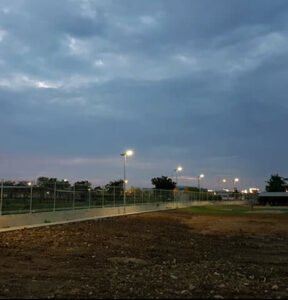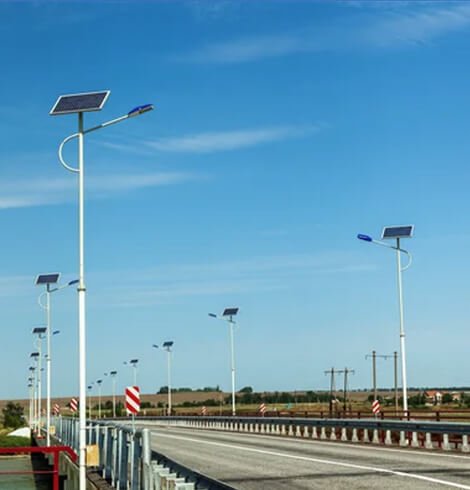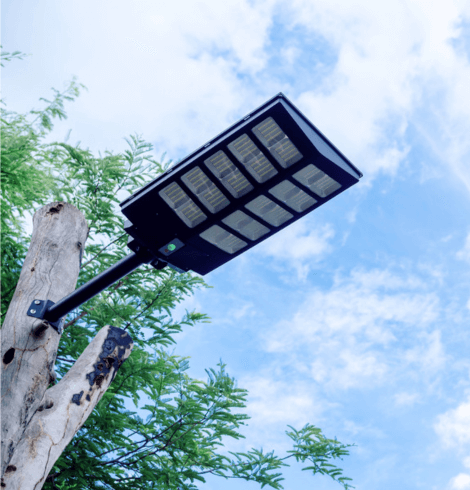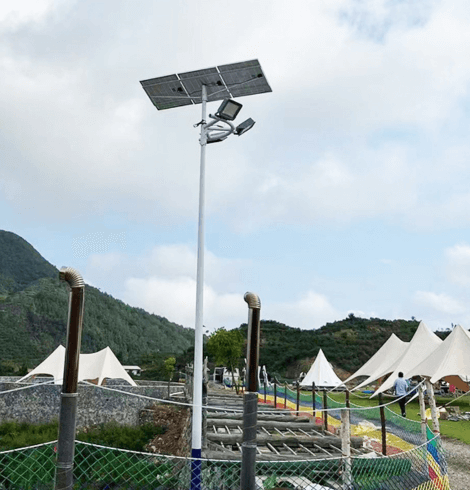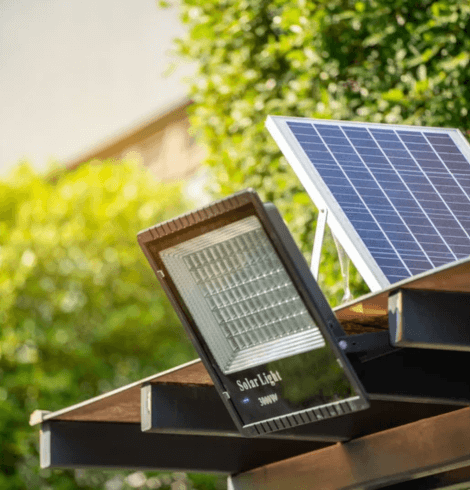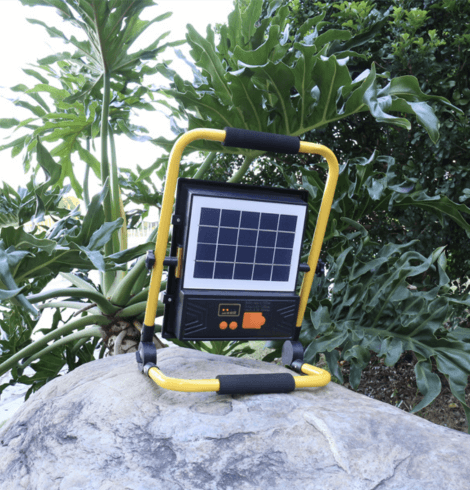Let’s say you’re planning your solar street light setup. Here’s a cheat sheet:
| Road Type | Recommended Pole Height | Typical Spacing | Target Brightness (Lux) |
| Residential streets | 3–5 meters | 15–30 meters | 5–15 lux |
| Urban commercial streets | 6–8 meters | 25–40 meters | 15–30 lux |
| Main roads / highways | 10–15 meters (up to 25 m) | 30–50 meters | 30–60+ lux |
| Pedestrian paths / parks | 3–4 meters | 10–20 meters | 10–20 lux |
Think of it like choosing shoes for different occasions. You wouldn’t wear hiking boots to a beach party — same goes for lighting. Match the pole height to the environment, traffic level, and safety needs.
Table of Contents
ToggleIntroduction
When we talk about solar street lights, we usually think about brightness, solar panels, or maybe battery life. But there’s one design choice that quietly makes or breaks your lighting project — the height of the light pole.
Too low? You get bright little circles on the ground, with deep shadows between them. Too high? The light might spread too thin, leaving your road dim. So, how tall is just right? Let’s walk through the logic together, so by the end, you’ll know exactly what height works for your road, path, or parking lot.
Why Solar Light Pole Height Matters?

The height of a solar light pole is like the zoom setting on a flashlight. Raise the flashlight, and the light spreads over a bigger area. Lower it, and the light gets focused into a bright circle. Sounds simple, but the impact is huge: A good design strikes a balance. You want even lighting, enough to safely walk or drive, but not so much that you’re wasting energy or flooding areas that don’t need light.
Higher pole = wider spread but dimmer on the ground
Lower pole = brighter spot directly underneath, but smaller coverage
A good design strikes a balance. You want even lighting, enough to safely walk or drive, but not so much that you’re wasting energy or flooding areas that don’t need light. Height also connects to other design factors:
Wattage of the lamp — a stronger light can afford to sit higher.
Road width — the wider the road, the taller the pole needs to be to light both sides.
Mounting arrangement — are lights on one side of the street or both?
Beam angle — wide-angle lights can sit higher than narrow-angled ones.
Environment — in windy, snowy, or shaded areas, pole height can help your solar panel stay efficient.
Recommended Pole Heights by Road Type
There’s no one-size-fits-all. Pole height depends on the type of road or area you’re lighting. Let’s go through the main categories one by one:
Residential Streets
Recommended Height: 3–5 meters
Why: These are calm, slow-traffic areas like neighborhood roads or private lanes.

Here, the lighting needs to be cozy and functional — enough for pedestrians and occasional cars, but not so strong that it floods into windows or overwhelms small spaces. A pole height of around 4–5 meters, with spacing of about 15–30 meters, usually provides gentle and uniform illumination.
This height keeps the beam low, so light stays focused on the street and sidewalk. Lower poles also reduce light pollution — great for residential peace and quiet.
Urban Commercial Streets
Recommended Height: 6–8 meters
Why: These are busier streets in commercial zones or downtown areas.
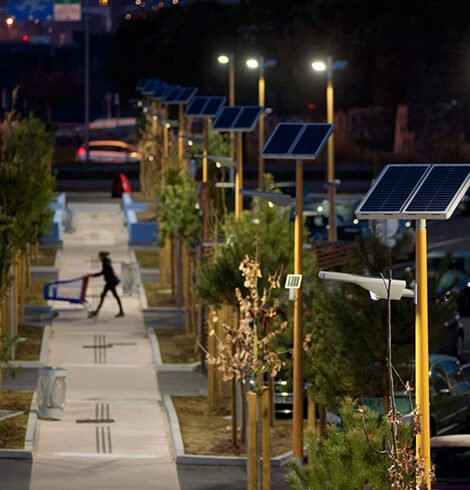
Here, you need both coverage and brightness. You want pedestrians to feel safe and vehicles to clearly see crosswalks, storefronts, and signage. Taller poles (~7–8 m) allow each lamp to cover a wider span — especially useful in roads with 2–3 lanes.
With proper optics, spacing around 25–40 meters works well. Just make sure your fixtures are powerful enough to maintain the recommended 15–30 lux of brightness even at that height.
Main Roads & Expressways
Recommended Height: 10–15 meters (can go up to 25 m for expressways)
Why: High speeds + wide roads = more demanding lighting.
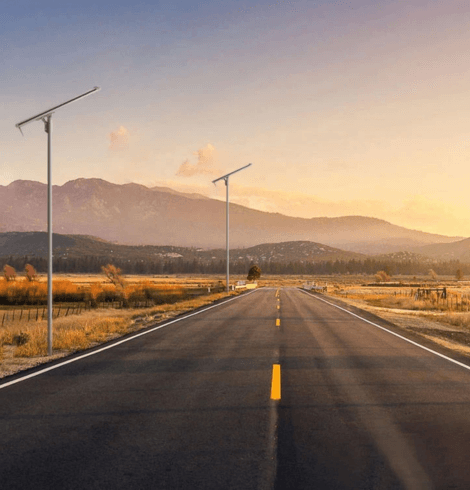
You’ve probably noticed that highways are lit with tall poles, often 10+ meters high. This isn’t for looks — it’s so that a single light can reach across wide lanes and still provide visibility at speed.
The catch? As you go higher, the lamp needs to be much brighter. These lights often output 10,000+ lumens and are spaced around 30–50 meters apart. For huge interchanges, high-mast lighting (20–30 m poles with multiple fixtures) might even be used. Designing for highways is about safety at speed — no flicker, no shadows, just smooth, even light across lanes.
Pedestrian Paths & Parks
Recommended Height: 3–4 meters
Why: These are low-speed, human-centered spaces.

Here, lighting is about ambience and visibility, not car headlights. You want people to feel safe walking, but without turning the path into a floodlit stadium.
Lower poles give a cozy, inviting glow and avoid glare. They’re often placed 10–20 meters apart with wide-beam fixtures, enough to light the path evenly without overpowering nearby nature or housing. Bonus: Short poles are easier to install and maintain — ideal for community parks and trails.
Regional and Local Considerations
Height Isn’t Universal — It’s Local. Every country — and even city — has its own lighting standards. Some towns prefer lower poles for aesthetics, others go tall to reduce the total number of poles. Some areas have strict dark-sky rules, limiting upward light. Some need to account for snow or tree cover, requiring taller poles for solar panel exposure.

So while the above numbers are great starting points, always double-check your local regulations. And if you’re designing a solar lighting plan? Talk to the manufacturer — they often provide free photometric designs based on your layout.
Quick Summary: Choosing the Right Pole Height
Pole height isn’t just a technical detail — it’s the foundation of how your solar lighting works. Get it right, and your road or pathway is safe, pleasant, and energy-efficient. Get it wrong, and you’re left with shadows, glare, or wasted light.
Start with the road type, check the local standards, and use the rule of thumb: Height = Coverage, but don’t forget: coverage needs power. With thoughtful planning and the right pole height, your solar lighting project will shine — in every sense.
Frequently Asked Questions (FAQs)
How Pole Height Affects Illuminance?
It’s all about the spread. The higher you go, the wider the light spreads — but the dimmer it gets on the ground. Think of it like a flashlight on the ceiling, the beam spreads out = bigger area lit. But each spot on the ground gets less light
So, if you increase the height, you usually need a stronger light to keep the ground bright enough. Otherwise, you’re just spreading too little light over too much area.
What Is The Optimal Pole Spacing Based on Height?

A simple rule of thumb: Spacing ≈ 2.5 to 3 × pole height
For a 6-meter pole, spacing is about 15–18 meters
For a 10-meter pole, spacing is about 25–30 meters
This keeps light levels smooth, without dark patches or glare zones. But spacing isn’t just about height — it also depends on your lamp’s beam angle, wattage, and how wide your road is.
Can I use lower solar street light poles to save costs?
Yes — but only if you understand the trade-off. Shorter poles are cheaper, and easier to install and maintain. But you’ll need more of them, closer together, to avoid gaps. And the light can feel harsh directly underneath, like a spotlight.
Use shorter poles in tight spaces like courtyards, sidewalks, or short lanes. For roads, cutting the pole height too much usually creates uneven lighting or requires extra fixtures.
Is taller solar light pole always better?
Nope. Taller poles offer wider coverage, but they also need stronger lights — which cost more and use bigger solar panels and batteries. Plus, very tall poles can be harder to maintain, and in windy areas, they need extra structural support.
Only go taller if the road width or application truly needs it. Otherwise, you’re just raising costs (and maybe adding wobble in a storm).
How do I verify if my pole height selection is correct?
Here’s a checklist:
- ✅ Does the light reach across the road width?
- ✅ Are there dark gaps between lights?
- ✅ Is the brightness level on the ground meeting the lux target (e.g. 10 lux for residential)?
- ✅ Is the spacing less than 3 × the pole height?
- ✅ Is the solar panel high enough to avoid tree shade or obstructions?
Still unsure? Ask the supplier for a photometric simulation. It’s a simple plan that shows how your lights will perform before you install a thing. Most manufacturers offer it for free if you tell them the road width, height, and desired brightness.



